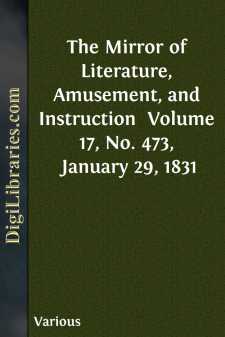Categories
- Antiques & Collectibles 13
- Architecture 36
- Art 48
- Bibles 22
- Biography & Autobiography 813
- Body, Mind & Spirit 142
- Business & Economics 28
- Children's Books 14
- Children's Fiction 11
- Computers 4
- Cooking 94
- Crafts & Hobbies 4
- Drama 346
- Education 46
- Family & Relationships 57
- Fiction 11829
- Games 19
- Gardening 17
- Health & Fitness 34
- History 1377
- House & Home 1
- Humor 147
- Juvenile Fiction 1873
- Juvenile Nonfiction 202
- Language Arts & Disciplines 88
- Law 16
- Literary Collections 686
- Literary Criticism 179
- Mathematics 13
- Medical 41
- Music 40
- Nature 179
- Non-Classifiable 1768
- Performing Arts 7
- Periodicals 1453
- Philosophy 64
- Photography 2
- Poetry 896
- Political Science 203
- Psychology 42
- Reference 154
- Religion 513
- Science 126
- Self-Help 84
- Social Science 81
- Sports & Recreation 34
- Study Aids 3
- Technology & Engineering 59
- Transportation 23
- Travel 463
- True Crime 29
The Mirror of Literature, Amusement, and Instruction Volume 17, No. 473, January 29, 1831
by: Various
Categories:
Description:
Excerpt
THE STRAND, ANCIENT AND MODERN.
(Inscription copied from the original of the annexed Engraving.)
In its ancient state, anno 1547.With the Strand Cross, Convent Garden, &c.
With the Procession of Edward VI.And its Neighbourhood, anno 1700.
Looking from Arundel House, northwards,
With the Maypole and Garland.
We have often, in our antiquarian notices of the Metropolis, touched upon the olden topography of COVENT GARDEN and THE STRAND, and illustrated our pages with some portion of its history. Thus, in vol. xii. p. 40, the "regular subscriber" will find, an Engraving, and descriptive notes of Old Covent Garden: in vol. xiii. p. 122, he will find a second notice of the same spot; and in the same volume, p. 241, is a whole-page Engraving of the original Somerset House, with ample details of its foundation, the neighbouring district, &c. The reader should turn to these pages, and re-read them in connexion with the few particulars we have now to add.
To aid the first Engraving, with the Strand Cross and Covent Garden, we may quote that—
"Most of the ground occupied by the above parish was, in ancient times (anno 1222), an extensive garden, belonging to the Abbot and Convent of Westminster, and thence called the Convent Garden, from which the present appellation is an evident corruption. This estate, with other contiguous lands of the Abbots, which were originally named the Elms, and afterwards Seven Acres, and Long Acre, having reverted to the town at the Dissolution, was given by Edward the Sixth to his ill-fated uncle, the Duke of Somerset; after whose attainder, as appears from the original Minutes of the Privy Council, there was a patent granted in March, 1552, to John Russell, Earl of Bedford, and Lord Privy Seal, per Bill. Dom. Regis 'of the gift of the Covent, or Convent Garden, lying in the parish of St. Martin in the Fields, near Charing Cross, with seven acres, called Long Acre, of the yearly value of 6l. 6s. 8d., parcel of the possessions of the late Duke of Somerset, to have to him and his heirs, reserving a tenure to the King's Majesty in socage, and not in capite.' Shortly after, the Earl of Bedford erected a mansion, principally of wood, for his town residence, near the bottom of what is now Southampton Street; and that building, which obtained the name of Bedford House, remained till the year 1704: it was inclosed by a brick wall, and had a large garden extending northward, nearly to the site of the present market-place."
The Engraving scarcely requires further explanation. The Royal Procession to the Convent in the distance, with the young King, Edward VI. beneath a canopy, has a picturesque, if not imposing effect. By the way, a Correspondent, who appears to delight in the quaint sublime, tells us that in digging the foundation of the Market just erected in Covent Garden, a quantity of human bones were dug from a rich black mould, at the depth of five feet from the surface, opposite James-street. "The Irish labourers threw them forth, and the sun again gleamed upon the probable particles of holy nuns, till the heavy feet of costermongers, &c....












